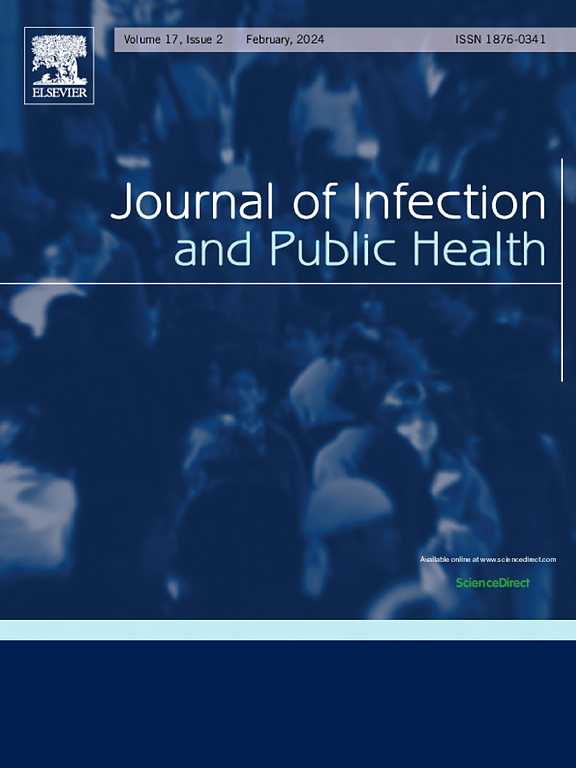Discovery of anti-Ebola virus multi-target inhibitors from traditional Chinese medicine database using molecular screening, biophysical investigation, and binding free energy calculations
IF 4.7
3区 医学
Q1 INFECTIOUS DISEASES
引用次数: 0
Abstract
Introduction
Ebola virus (EBOV) is a highly lethal RNA virus that causes severe hemorrhagic fever in humans and non-human primates. The lack of effective treatment or vaccine for this pathogen poses a serious threat to a global pandemic. Therefore, it is imperative to explore new drugs and therapies to combat this life-threatening infection.
Materials and methods
In this study, we employed in silico methods to assess the inhibitory activity of natural products from traditional Chinese medicine (TCM) against four EBOV proteins that are crucial for viral replication and assembly: VP40, VP35, VP30, and VP24. We performed molecular docking of TCM compounds with the EBOV proteins and screened them based on their docking scores, binding free energies, and pharmacokinetic properties.
Results
Our results pinpointed eight TCM compounds (TCM1797, TCM2872, TCM250, TCM2837, TCM2644, TCM4697, TCM2322, and TCM277) that exhibited superior efficacy in inhibiting all the EBOV proteins compared to the controls. These compounds interacted with key residues of the EBOV proteins through various types of bonds, such as hydrogen bonds, salt bridges, and π-π interactions, forming stable complexes that could disrupt the function of the EBOV proteins. These compounds were found to possess known antiviral activity, acceptable pharmacokinetic properties, and human usage history, which make them promising candidates for anti-EBOV drug development. Moreover, the molecular simulation analysis confirmed the binding stability, structural compactness, and residue flexibility properties of these compounds. Furthermore, the binding free energy results revealed that VP30-TCM2644, VP30-TCM4697, VP35-TCM2837, VP24-TCM250, and VP24-TCM277 complexes exhibit significant binding free energy values compared to the control ligands. Principal Component Analysis (PCA) and Free Energy Landscape (FEL) results revealed the trajectories' motion and conformational energy states.
Conclusions
Our findings provide valuable insights into the molecular mechanisms driving the efficacy of TCM drugs against EBOV and suggest novel approaches for the development of anti-EBOV therapies.
通过分子筛选、生物物理研究和结合自由能计算,从中药数据库中发现抗埃博拉病毒多靶点抑制剂。
导言:埃博拉病毒(EBOV)是一种高度致命的 RNA 病毒,可导致人类和非人灵长类动物严重出血热。这种病原体缺乏有效的治疗方法或疫苗,严重威胁着全球大流行。因此,当务之急是探索新的药物和疗法来对抗这种威胁生命的感染:在本研究中,我们采用硅学方法评估了中药天然产物对四种EBOV蛋白的抑制活性,这四种蛋白对病毒的复制和组装至关重要:VP40、VP35、VP30和VP24。我们进行了中药化合物与 EBOV 蛋白的分子对接,并根据对接得分、结合自由能和药代动力学特性对它们进行了筛选:结果:与对照组相比,我们发现8个中药化合物(TCM1797、TCM2872、TCM250、TCM2837、TCM2644、TCM4697、TCM2322和TCM277)在抑制所有EBOV蛋白方面表现出卓越的疗效。这些化合物通过氢键、盐桥和π-π相互作用等各种键与 EBOV 蛋白的关键残基相互作用,形成稳定的复合物,从而破坏 EBOV 蛋白的功能。研究发现,这些化合物具有已知的抗病毒活性、可接受的药代动力学特性和人类使用史,因此有望成为抗 EBOV 药物开发的候选化合物。此外,分子模拟分析证实了这些化合物的结合稳定性、结构紧密性和残基灵活性。此外,结合自由能结果显示,与对照配体相比,VP30-TCM2644、VP30-TCM4697、VP35-TCM2837、VP24-TCM250 和 VP24-TCM277 复合物表现出显著的结合自由能值。主成分分析(PCA)和自由能景观(FEL)结果显示了轨迹的运动和构象能态:我们的研究结果为了解驱动中药抗 EBOV 药效的分子机制提供了有价值的见解,并为开发抗 EBOV 疗法提供了新方法。
本文章由计算机程序翻译,如有差异,请以英文原文为准。
求助全文
约1分钟内获得全文
求助全文
来源期刊

Journal of Infection and Public Health
PUBLIC, ENVIRONMENTAL & OCCUPATIONAL HEALTH -INFECTIOUS DISEASES
CiteScore
13.10
自引率
1.50%
发文量
203
审稿时长
96 days
期刊介绍:
The Journal of Infection and Public Health, first official journal of the Saudi Arabian Ministry of National Guard Health Affairs, King Saud Bin Abdulaziz University for Health Sciences and the Saudi Association for Public Health, aims to be the foremost scientific, peer-reviewed journal encompassing infection prevention and control, microbiology, infectious diseases, public health and the application of healthcare epidemiology to the evaluation of health outcomes. The point of view of the journal is that infection and public health are closely intertwined and that advances in one area will have positive consequences on the other.
The journal will be useful to all health professionals who are partners in the management of patients with communicable diseases, keeping them up to date. The journal is proud to have an international and diverse editorial board that will assist and facilitate the publication of articles that reflect a global view on infection control and public health, as well as emphasizing our focus on supporting the needs of public health practitioners.
It is our aim to improve healthcare by reducing risk of infection and related adverse outcomes by critical review, selection, and dissemination of new and relevant information in the field of infection control, public health and infectious diseases in all healthcare settings and the community.
 求助内容:
求助内容: 应助结果提醒方式:
应助结果提醒方式:


